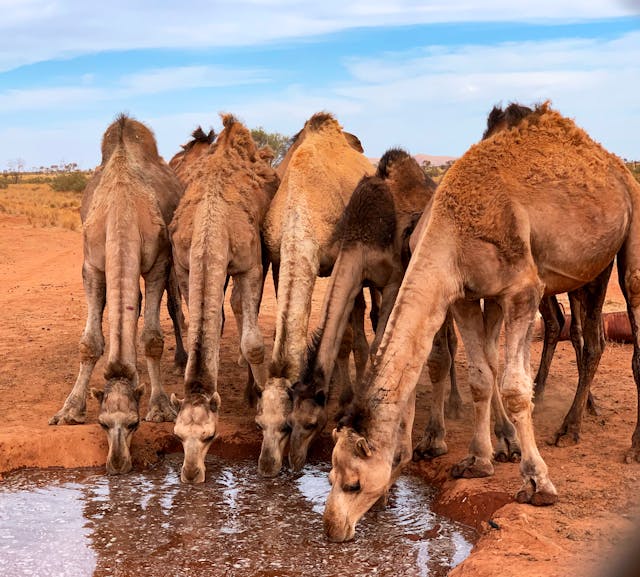
Why are there so many camels in Australia? There are so many camels in Australia because they were shipped over to make exploring the interior and laying telegraph lines easier.
When you think of camels, you probably think of hot African desert countries, probably around the Sahara Desert. Well, you are not wrong. The country with the largest camel population is Somalia, with more than 7 million camels, both wild and tame. The next few countries are Sudan and Kenya. Countries like Afghanistan and Pakistan also have a lot of camels. There are many camels in the deserts of the Middle Eastern countries, and there are even camels in the deserts of China. Most people don’t expect there to be camels in Australia, but there are actually over one million of them. There are so many camels that they’re considered a pest and there are various programs to cull them. Wild camels are a problem because they feed on crops, knock down fences, foul water holes, and can damage other infrastructure. The government of Australia says that if they don’t cull them, the number will double by next year.
So, how did Australia end up with so many camels? They are an invasive species. Australia was one of the first continents to break away from the mainland and all of their wildlife have been separated from the rest of the world for millions of years. When the Europeans arrived, they decided to introduce some of their native animals, which didn’t go well for Australia. Rabbits are probably the best example. A man called Thomas Austin took 13 wild rabbits from England to Victoria, Australia. He released them, thinking it would make some good hunting for him and his friends. Now there are over 200 million rabbits in Australia and they are a huge pest. They have been more controlled recently, and they probably peaked at 10 billion in 1920. Camels are the same.
The early settlers to Australia wanted to explore the center of the continent. Many people felt that there might be an internal sea there, but when they discovered it was land all of the way, and most of that desert, they began to think how they could explore it. Horses weren’t hardy enough to travel across the desert and they needed more water than the explorers could carry. Camels are very strong, they have feat suited to walk on sand, and they can go for long periods of time without drinking. These early settlers reached out into the British Empire, and they imported camels from the Arabian Peninsula, India, and Afghanistan. (Afghanistan wasn’t part of the empire, but it was controlled by Britain.) These first camels came with camel handlers and they were very successful. They could travel large distances over the hot desert and they could carry large loads. The invasion of camels might have stopped there if it hadn’t been for the telegraph.
In the second half of the 19th century, the telegraph was crossing the world. It was the reason why we could have war journalists, and it changed society. It also changed Australia. Before the telegraph, the only way to communicate with Britain, where many of the settlers had come from, was by ship, which took months. It could be a year before you got a reply. The telegraph used regional stations to intercept and send on the message, and a message could get to Britain and back in hours. The telegraph only works if the cables are connected because it works by sending an electrical signal along the cable. There was no way to make a wireless signal. Countries were connected to undersea cables. Australia was connected to the undersea cable at Darwin. The cable ran from Java down to Darwin. To connect the southern Australian cities of Adelaide and Melbourne to the telegraph, it was necessary to run a cable from Darwin, across the desert, and down to the south. The only way this could be done was with more camels.
Plans to build the line started in 1870 and all of the work was finished by 1872. The line was over 2,000 km long and it had 36,000 telegraph poles. There were 11 repeater stations 200 km apart to boost the strength of the signal. All of this was only possible because of the camels. When the idea became a real plan, 15,000 camels with their handlers were imported into Australia. They carried all of the poles and equipment into the desert and were a vital part of the telegraph line. After that, they were used for trading across the desert, but by the early 20th century, trade moved to roads and railways. The camels were no longer needed. Many were still used in small areas, but the majority were left to go wild. And that is where the problems started. And this is what I learned today.
Sources
https://en.wikipedia.org/wiki/European_land_exploration_of_Australia
https://www.bbc.com/travel/article/20180410-the-strange-story-of-australias-wild-camel
https://nt.gov.au/environment/animals/feral-animals/feral-camel
https://digital-classroom.nma.gov.au/defining-moments/rabbits-introduced
https://www.nma.gov.au/defining-moments/resources/overland-telegraph Photo by Mark Vegera: https://www.pexels.com/photo/camels-drinking-on-the-desert-5347142/

Pingback: #547 How is the Internet connected between countries?
Pingback: #726 Why does Australia have so many dangerous animals?